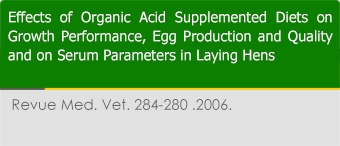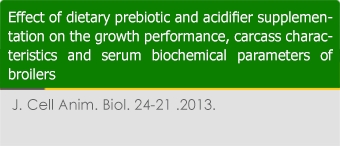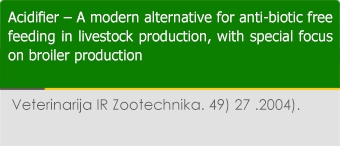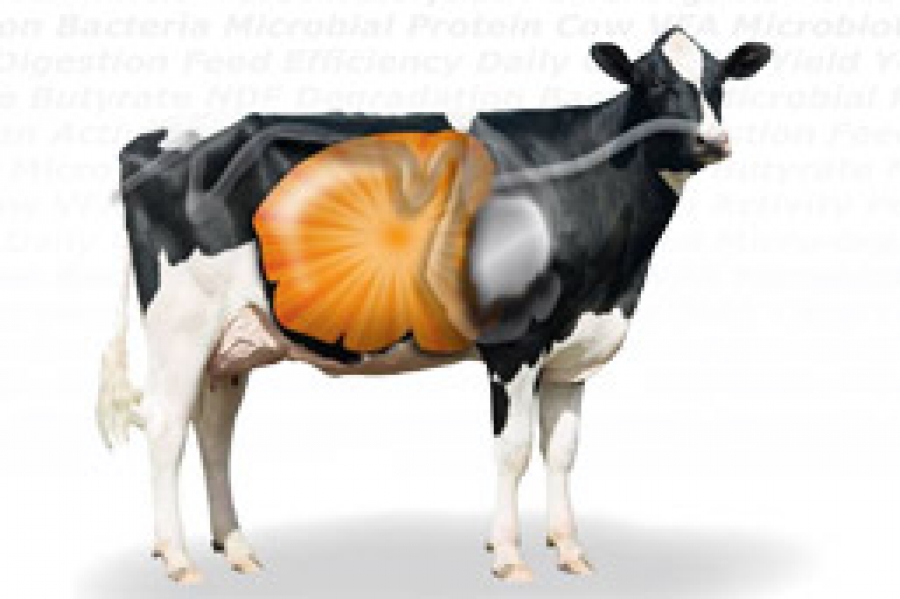Samli H. E., G. Sirci, J. Lorenzo Bermejo, F. Koc, A. Agma Okur, and N. Senkoylu
The present study investigated the relationship between addition of a commercial organic acid mixture to feed and feed microbiology. Feedstuffs’ composition and duration, temperature and humidity of feed storage were taken into account. The evaluated organic mixture contained formic acid, ammonium formate, propionic acid, ammonium propionate and inorganic phyllosilicate carrier. Microbiological changes were investigated in five types of feed using a 2×2×2 factorial design: organic acid addition (with/without), conditions of storage (228C and 57% relative humidity (HR)/418C and 65% HR) and storage duration (30/60 days). Supplementation of the organic acid mixture has positive effect on feed microbiology.
Samli H. E., G. Sirci, J. Lorenzo Bermejo, F. Koc, A. Agma Okur, and N. Senkoylu
The present study investigated the relationship between addition of a commercial organic acid mixture to feed and feed microbiology. Feedstuffs’ composition and duration, temperature and humidity of feed storage were taken into account. The evaluated organic mixture contained formic acid, ammonium formate, propionic acid, ammonium propionate and inorganic phyllosilicate carrier. Microbiological changes were investigated in five types of feed using a 2×2×2 factorial design: organic acid addition (with/without), conditions of storage (228C and 57% relative humidity (HR)/418C and 65% HR) and storage duration (30/60 days). Supplementation of the organic acid mixture has positive effect on feed microbiology.
Celik, K., I. E. Ersoy, A. Uzatici, and M. Erturk
The experiment described evaluated the effect of a commercial in-feed preparation (Biotronic® SE) involving a mixture of organic acids and salts on California turkey chicks performance. In these experiments, 1-d-old commercial white turkey poults were placed into battery brooders and were given turkey starter feed and water ad libitum. Biotronic ® SE had very small effect on the body weight gain (BWG) when included in the feed and live bird performance was not adversely affected by feeding up to 2.0%. from 0 to 60 days as based groups.
S. Cakir, M. Midilli, H. Erol, N. Simsek, M. Cinar, A. Altintas, H. Alp, L. Altintas, O. Cengiz, A. Antalyali
The aim of the present study was to compare the effects of Biomin®IMBO (combination of probiotic, prebiotic, phytogenic substances and cell wall fragments), of Biotronic (combination of formic and propionic acid based on an inorganic phyllosilicate carrier), of a combination of the Biomin® IMBO and Biotronic and of an antibiotic, avilamycin, as feed additives on the growth performance, several serum parameters and digestive villus height of quails. A total of 300 1-day-old Japanese quail chicks were randomly divided into 5 experimental groups with 4 replicates of 15 birds per replicate.
Nataliya Roth, Thomas Germ, Alfred Klimitsch, Renata Urbaityte, Sabine Nitsch
The inhibitory effect of acids on bacterial growth has long been used to preserve feed from spoilage. The use of organic acids as acidifiers for swine and poultry is also well known. In the present study the antimicrobial activities of formic and propionic acids and their combination were investigated in vitro on E.coli and Salmonella typhimurium, as these pathogens cause problems in animal production. The combination of acids was more effective than the effect of individual acids together. The reason of the synergy between organic acids blends can be the combination of acid with a low pKa, which reduces the pH of the environment of bacterial cells and acid with a high pKa and low molecular weight to ensure an antimicrobial effect inside the cell. The efficacy of the combination of formic and
Senkoylu N, Samli H. E., Kanter M., Agma A
Day-old male chicks were used to test the effects of a combination of formic and propionic acids (CFP) added to wheat- and barley-based diets on the performance and gut histomorphology of broilers. The CFP, containing formic and propionic acids based on an inorganic phyllo-silicate carrier, was added to starter and grower broiler diets of standard (NRC, 1994) or lower nutrient density (LND) using different levels of wheat and barley. Body weight gain (BWG) and feed conversion ratio (FCR) of broiler chicks were significantly (P < 0.001) improved by CFP supplementation at 21 days of age regardless of nutrient density (ND). However, at 35 days of age CFP addition significantly (P < 0.001) increased BWG and FCR. Proventriculus weight was also significantly affected by the dietary treatments.
N. Roth1, M. Rouault, R. Urbaityte, S. Masching, T. Applegate
The efficacy of an acidifier in the liquid form and the same composition on the special carrier Sequential Release Medium (SRM) (Biotronic SE forte) was investigated with broilers. Ross broilers (612) were divided into three treatment groups with 8 replicate pens per treatment. One group received 3 kg of the liquid formic and propionic acids per ton of feed, the second group was fed the same combination on SRM and the third group did not recive any feed additives. Chicks were kept in stressing conditions: reduced ventilation, recycled litter, and higher temperature (>29○C) from hatch to 24 days of age. Birds fed acids in a liquid form were numerically 3.2% heavier in comparison to the control group (P>0.05), while the group fed acids on SRM were 4.9% heavier than control (P<0.05).
Senkoylu, N., H. E. Samli, H. Akyürek, A. Agma
Day-old male 240 chicks of a Ross 308 strain were used to test the effects of an commercial organic acid (OA), Biotronic SE Forte, on broiler performance and gut histomorphology. OA preparation was supplemented at 3 g/kg level into starter and finisher broiler diets of standard (NRC, 1994) or lower (approximately 10%) nutrient density (ND). Thus, the experiment was set up according to 2x2 factorial design with 6 reps of 10 birds allocated in each. BWG and FCR of broiler chicks both at 21 and 35 d experimental periods were significantly (P<0.001) improved by OA supplementation regardless of the diets ND. OA supplementation increased BWG by approximately 20% in 21 and 12% in 35 d experimental periods. FCR value dropped from 1.276 to 1.105 and from 1.263 to 1.129 in the two group fed with standart or
Fallah R. and H. Rezaei
This study investigated the effect of dietary supplementation with the fermacto prebiotic and Biotronic S.E (an acidifier) on the growth performance, carcass characteristics and serum biochemical parameters of broiler chickens. 240 day old Ross 308 broilers were equally distributed into 24 floor pens and reared for 42 days. A basal diet was formulated according to the recommendations of NRC for starter (1 to 21 days) and grower (22 to 42 days) periods and considered as control diet. Four tested diets were formulated as listed control diet (without any additives), fermacto prebiotic, Biotronic S.E (an acidifier) and mixture of fermacto prebiotic plus Biotronic S.E. Six replicate were used for each treatment. The results of this study indicate that addition of fermacto prebiotic and Biotronic S.E increased the final body weight,
N. Simsek, I. Can, A. Karadeniz, A. Kara and R. Gumus
The present study aimed to evaluate immunohistochemical changes of mucinand serotonin-releasing cells in the small intestine induced by various dietary supplementations in quails. A total of 300 one day old quails were randomly divided into 5 equal groups according to the 5 weeks long supplementation: whereas birds of the group 1 were fed with basal diet, the others were supplemented with prebiotics/probiotics (1 g/kg food, group 2), with organic acids (4 g/kg food, group 3), with both prebiotics/probiotics and organic acids (same dosages, group 4) or with antibiotic (active form of avilamycin, 10 mg/kg food, group 5). Weight growth and food intake were not modified among groups. Density of goblet cells were markedly increased mainly in ileum in all supplemented groups
Luckstadt, C., N. Şenkoylu, H. Akyurek, A. Agma
The potential of organic acids in feed preservation, protecting feed from microbial and fungal destruction, but also directly in the animal nutrition is already known for decades and was proven in uncounted laboratory and field trials. However, the knowledge of effects from synergistically acting organic acid blends of high biological value together with organic or inorganic physiologically active carriers to the animal is relatively new. A trial with broiler chicken over a period of 35 days was carried out with an organic acid blend on an inorganic carrier (3 kg inclusion rate per ton of feed) against a control without an acidifier. Results proved significantly (p < 0.05) the growth enhancing action of the acidifier. From this results it can be concluded that acidifiers containing well balanced acid combination can increase
حسن قهري، محمود شیوازاد، پرویز فرهومند، جاوید اقبال، مهدي نجف زاده
جهت بررسی تاثیر سطوح مختلف اسیدهاي آلی (مکمل حاوي اسید پروپیونیک و اسید فرمیک) بر عملکرد جوجه هاي گوشتی، طرح کاملا تصادفی در چهار سطح (صفر، 5/0، 0/1 و 5/1 درصد در جیره) و سه تکرار که جمعا 12 واحد آزمایشی را تشکیل می داد و با د ر نظر گرفتن 16 قطعه در هر واحد آزمایشی، جمعاً بر روي 192 قطعه جوجه گوشتی انجام پذیرفت. تجزیه وتحلیل آماري داده ها با استفاده از بسته نرم افزاري ماستات-سی مقایسه میانگین ها از طریق آزمون دانکن انجام پذیرفت. تفاوت معنی داري د ر دوره هاي مختلف از نظر میزان مصرف خوراك در بین تیمارهاي آزمایشی مشاهده نگردید. اما افزایش وزن بدن در طی دوره آغازین در بین تیمارها تفاوت معنی داري داشت. علیرغم اینکه با افزایش سطح استفاد ه از اسیدهاي آلی در دوره رشد و کل دوره (42- 0 روزگی) افزایش وزن بدن بهبود یافته بود



















